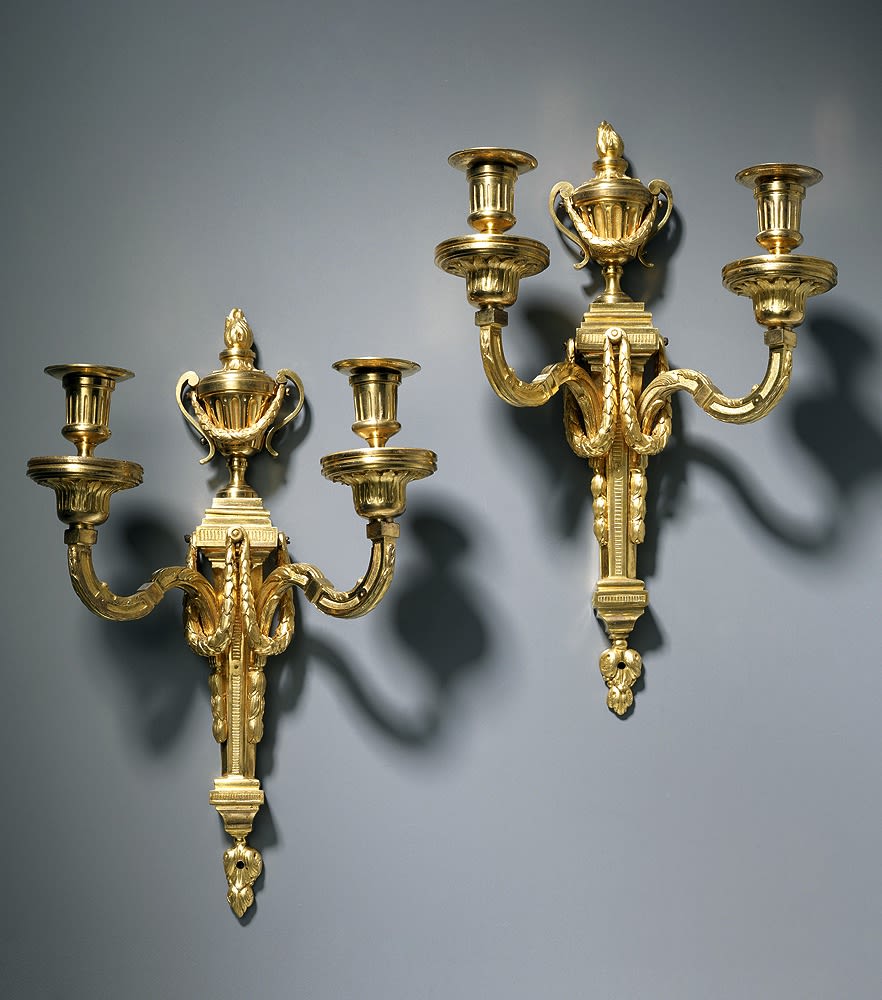Jean-Louis Prieur (attributed to)
A very fine pair of Louis XVI gilt bronze two-light wall-lights attributed to Jean-Louis Prieur each with a swagged flaming urn finial above two foliate branches with fluted drip-pans and nozzles, the fluted tapering shaft with laurel swags and foliate boss
Paris, date circa 1770
Height 41 cm, width 26 cm. each.
These wall-lights are typical of the work of Jean-Louis Prieur (b. 1732-6 d. 1795). They are identical to models by him of 1770 in the Württembergisches Landesmuseum, Stuttgart and at Stockholm Castle, illustrated in Hans Ottomeyer and Peter Pröschel, "Vergoldete Bronzen", 1986, p.173, pl. 3.5.6. A variation of the design with three lights can be found at the J. Paul Getty Museum, California and at Stockholm Castle (illustrated in Ottomeyer and Pröschel, ibid, p. 172, pl. 3.5.4.)
One of the leading exponents of the Neo-classical style, Prieur worked as a sculptor, bronze castor and chaser, designer and engraver. Like the slightly younger, celebrated bronzier, Pierre-Philippe Thomire (1751-1843), Prieur initially studied sculpture at the Académie de Saint-Luc, Paris, 1765. The following year he collaborated with Victor-Louis and Philippe Caffiéri on the decoration of the Royal Castle at Warsaw where he provided designs for furniture and objects, some of which he executed. He also worked with Victor-Louis on the redecoration of Chartres Cathedral choir.
In 1769 he was received as a maître fondeur-ciseleur, possibly having been trained under his cousin, Jean-Joseph de Saint-Germain. Prieur executed a number of important bronze clock cases, notably one of 1770 featuring Peace and Abundance (Hermitage, St. Petersburg) made on the occasion of the marriage of the Dauphin (later Louis XVI) and Marie-Antoinette. When Louis XVI was crowned King of France, Prieur produced bronze ornaments for his coronation coach. In 1776 he supplied bronzes for two mantelpieces for the Palais-Bourbon. But in 1778 he suffered severe financial difficulties due to mishandling of funds. He was forced to move to Enclos du Temple, Paris were he continued to operate as a caster but on a much smaller scale. During the 1780's Prieur published a number of engravings of ornamental designs, he produced seven books featuring designs for furniture, vases and arabesques and also published six plates of scrolling, foliate friezes entitled 'Principes de Dessin'. In addition he designed for wallpaper for the factory of Jean-Baptiste Réveillon.
